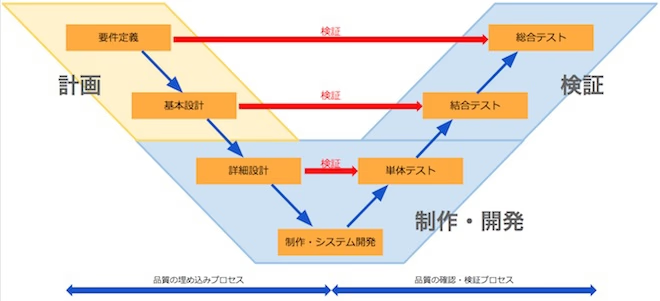Hello, this is Kamii from the production department.
With the rapid changes in the environment surrounding the Internet, the technology required is becoming more extensive and sophisticated. As a result, website renewal projects often leave some issues unresolved.
This is the second of a six-part intensive short series in which we aim to inform client-side webmasters of what they need to keep in mind not only as clients and contractors, but also as co-leaders of project teams.
In the previous article, " Part 1: QCD Accuracy and Budget - Recommending Two-Stage Ordering, " we explained the benefits of two-stage ordering, which views projects as a V-model consisting of a "planning phase" and a "construction and verification phase," and involves making estimates for the construction and verification phase at the completion of the planning phase.
In the second installment of this series, we will talk about how to proceed with the planning phase.
Planned serialization (titles from the second installment onwards are tentative)
Part 1: QCD Accuracy and Budget - Two-stage Ordering (January 17, 2019)
Part 2: How to proceed with the planning phase ~Webmasters and project managers are the two wheels of project promotion~ (this time)
Part 3: Security response, maintenance and operation Part 4: The role of the webmaster in the upstream process and the skills required of designers Part 5: Project scale and resources Part 6: Waterfall model and agile development
What is the purpose of the planning phase?
As mentioned in the previous article, in the planning phase (requirements definition to basic design), the project scope and production specifications are planned and compiled into design documents. This determines the total quantity and difficulty of the site construction.
Once the total quantity and level of difficulty have been determined, it becomes possible to plan the personnel required for construction and estimate the labor hours required.
Based on this manpower plan and labor hour estimate, a process plan is drawn up and costs are calculated.
An important goal of the planning phase (requirements definition to basic design) is to determine the QCD for the construction phase.
・Quality (specifications) : Determine the total quantity of the construction phase and production specifications (level of difficulty).
・Cost : Determine the manpower plan based on "Q: Specifications". Calculate the cost.
・Delivery (construction period) : Determine the process plan based on "Q: Specifications".
Also, if we view a project as a V-model, as shown in the diagram below, the output of the planning phase (requirements definition to basic design) is the input to the production and development process, and also serves as the creation of standards for the verification process (testing).
<Figure> V-model | Development process from the perspective of quality assurance

The planning phase (requirements definition to basic design) is the process in which the production company determines the QCD for production and development, and the client determines the standards for acceptance.
The materials compiled here must clearly communicate the production specifications to the engineers in charge of production and development on the production company's side, and must also be easy for the client to understand, explaining the methods and procedures that will be used to realize the requests that have been presented.
What are the changes in plans that lead to changes in estimates?
As you progress through the planning phase and solidify the required specifications (Quality), changes to the plan that lead to changes to the budget (Cost), schedule, and delivery time estimated before the project began can be classified into the following three categories:
Changes in project scope
Once work has commenced, the project scope may be expanded through detailed surveys of the existing site and elaboration of business requirements.
There are frequent increases in the volume of production, such as pages that could not be identified during external investigations when creating the initial estimate, or pages that the production company deemed to be of low importance and therefore not included in the production, but were then asked to be moved to the new site.
Changes in production and development specifications
There are cases where the system specifications cannot be understood through prior external investigation, such as pages that have mechanisms for displaying different content depending on the conditions for accessing the page or the user's attributes.
Furthermore, if the server running the site is significantly different from the de facto standard configuration, it may become necessary to change the development specifications and construction procedures, as well as the publication procedures after the renewed site is completed, which may increase the amount of work required.
If changes or additions to the development specifications that were not included in the original estimate arise, not only will costs and construction time have to be reviewed, but staffing plans may also have to be revised if the skill set of the engineers originally planned by the production company is not enough to handle the work.
Additional support on the client side
As the design progresses and the development specifications are finalized, the client may encounter additional tasks and arrangements that need to be handled.
In this case, it may be necessary to change the client's project execution budget rather than the ordering fee to the production company.
When specifications are decided during the planning phase (requirements definition to basic design), it is difficult to avoid changes to the plans from the required specifications assumed at the time of ordering.
Changes in specifications (Quality) lead to changes in budget (Cost) and schedule/delivery. If the production volume increases significantly or the development specifications become more difficult, it is inevitable that production costs will rise and the production schedule will be extended.
How to proceed through the planning phase
So, how should you proceed through the planning phase in order to respond appropriately to changes in plans and keep the project running smoothly?
Prioritize requirements
If the development specifications meet all of the originally planned requests, and the budget and construction period are not within the budget, the required specifications (Quality) will be reduced to adjust the budget (Cost) and construction period (Delivery). To consider this adjustment, the client's webmaster needs to determine the priority of the required specifications.
However, depending on the production and development methods and procedures, it may be difficult to prioritize the required specifications according to the business requirements. It is necessary for the client's webmaster and the production company's project manager to work together to find the optimal solution.
Decide what to do, what to stop, and what to put off
Adjusting the scope of work in order to fit within the original budget and construction period also means, from the client's perspective, giving up some of the things they wanted to do with the renovation.
What you need to consider here is whether there is anything that can be covered by operating the site after the renewal is complete, whether there are any required specifications that will have limited or no expected effect even if implemented, or whether there are any issues that can be delayed as secondary development without any problems.
Here too, collaboration between the production company, responsible for research and design, and the client's webmaster, who is in charge of site operation, is essential.
If the cost (C) or schedule/time (D) needs to be changed from what was expected at the time of ordering as the planning phase progresses, the client and the production company will work together to find the optimal solution. To ensure the project proceeds smoothly, it is important to make this decision smoothly.
To do this, cooperation from the client's webmaster may be essential.
Check the approval flow
Changes to the budget or construction schedule, or arranging internal procedures that were not anticipated at the start of the site renewal project, will require approval from the client.
Also, if a two-stage ordering is used, the development specifications (Q), cost (C), and schedule (D) decided in the planning phase will become the ordering specifications for the construction phase, so it is important to review and approve the design documents prepared here.
This will require the client's webmaster to make the necessary internal adjustments and procedures. Please check the approval flow and the number of days required for the procedure.
Understanding the design
In order for the client's webmaster to smoothly proceed with these approval procedures, he or she will be required to take the lead in reaching a consensus within the client's company regarding the decided specifications and any associated changes to the budget and construction schedule.
Basic design is the process of determining the methods and procedures to be used to realize the requests and compiling them into design documents. Of course, the production company must summarize the documents in a way that is easy for the client to understand, but there are times when it is unavoidable to document them using technical terms used in production and development.
When developing a web system, the business flow that the client executes in the office is replaced with a data processing process on the program. In order to determine whether the process and logic designed here satisfies the business requirements, it is necessary to read the design documents and understand the program development specifications.
Of course, the project manager on the production company side must make every effort to gain this understanding. However, we also ask the webmaster on the client side to take steps to ensure that there are no oversights or misunderstandings regarding the understanding and judgment of this matter.
Schedule with approval process in mind
As mentioned above, the approval process for the contents of the planning phase cannot be shortened by the efforts of the project execution members.
It is also the process for the client to determine the acceptance criteria, and it is important to allocate sufficient time to understand the approval content and prevent oversights or misunderstandings.
Therefore, be sure to plan your schedule well in advance.
During the planning phase, which determines the QCD for the construction and verification phases, the project manager from the production company who oversees the project's execution members and the webmaster from the client's side who is responsible for decision-making as the project progresses are the two wheels that drive the project forward.
When renovating a corporate website, the client's webmaster will often be responsible for their regular duties, but it is also important that they make internal arrangements to ensure that sufficient time is dedicated to the renovation project during the planning phase.
The second part of this intensive series was titled "How to Proceed with the Planning Phase - Web master and project manager are the two wheels of project promotion", and discussed the importance of collaboration between the client's web master and the production company's project manager in order to organize factors that may cause changes to the initial budget (Cost) and process/construction period (Delivery) as the required specifications (Quality) are solidified in the requirements definition and basic design stages, and to respond appropriately to changes in the plan and proceed smoothly with the project.
In the next article, titled "Part 3: Security response, maintenance, and operations," I will talk about the balance between preparing for information security risks and costs.
